Maybe there is a road map for journalists wiping the crumbs off their front and starting to talk about immigration. Some of them need it.
We should understand that this will be profoundly difficult for those journalists in organisations – let us start with Ninefax, someone else’s ABC and the Guardian – who have had any thought about reporting on immigration for most of a generation pooh-poohed.
It will require an adjustment in thinking that the bulk of the Australian electorate has already made.
Their initial reaction will be one of years’ worth of ingrained hostility toward the very idea they are now writing about. Soon after, spurious numbers will follow, blameless decision-makers, unfortunate events, ‘victims’ of the unfair narrative, and the spectre of ill-informed masses going feral the moment they cease paying attention to the narrative as described by informed people. People just like them are now making a major change. Being gentle should be the mindset.
Laura Tingle is one such person. I am actually a fan of hers and believe she writes credibly on a number of subjects. But immigration isn’t one of them.
Peter Dutton – almost certainly for his own 2025 political ends, and setting aside he was a high-ranking minister in three successive Liberal governments which ran the population Ponzi full bore until Covid, and quite likely using words to convey a firmer stance than he may have on the subject – has ensured that immigration will be front and centre of the upcoming election campaign.
That means Laura and lots of people just like her are going to have to learn about immigration and what the Australian public thinks, knows, and experiences. People beyond Brunswick or Northcote, Manuka or Lyneham, or beyond Petersham and Spit Junction.
Let’s take a look at today’s offering from Laura………
With his federal budget reply, Peter Dutton is now playing deadly simple but very dangerous politics
By Laura Tingle
Announcements on immigration (various) by the federal Coalition have been hard to miss in recent decades.
From John Howard talking about Asian immigration in the 1980s to Stopping the Boats in 2013, there’s always been a lot happening politically in that space.
Laura goes back to the 1980s and comes away with John Winston Howard and then transponds to 2013 and Tony Abbott stopping the boats.
That tells you how little say Australians have had on immigration right there and how largely united both mainstream sides of politics have been about avoiding any contemplation of the issue in elections or in the public domain. We should thank her.
The unity has been buttressed by the media, academia, and, of course, any self-respecting public servant. A range of taxpayer-funded lobby groups, not to mention margin-harvesting banks, telcos, retailers, and the construction and real estate lobbies also support mass migration.
As a result, the public hasn’t generally got a look in. ‘A lot happening politically’ means ‘sweet FA’ as far as people like you and me are concerned.
The real question is why it’s coming up now – and we will get there in due course.
Opposition Leader Peter Dutton — no stranger to the vibe as a former home affairs minister — was back there this week: snapping off the various threads of debate about Jim Chalmers’s third budget with the simple proposition that a Coalition government would cut migration and foreign investment in housing to make it easier for Australians to get a home.
In doing so, he honed in with deadly precision on the hot-button issue of our housing crisis.
Tingle rightly identifies that Dutton, despite coming across as bringing an important issue into the public domain, has historically been amongst the most influential members of a Cabinet that, for a decade, ran the Population Ponzi without demur – implying questions about his motives for doing so now. Those questions are quite legitimate.
She states that his proposition is that a fewer migrants equals easier homes. That’s true, but she doesn’t go within a bulls roar of asking – as any really good journalist or a strong editorial chain would do – how it could be that such a simple proposition could even be plausible.
Tingle then identifies it as a ‘hot issue’ while still not even gesturing to why a simple proposition could actually be that plausible, or why an opposition leader she notes has been part of the dynamic would come out with it now.
That’s a failure there.
Any politician is entitled to put forward a policy proposal for fixing a tough policy problem. The Greens, of course, have been running hard on housing for some time.
The second sentence of this stanza is the ‘over there’ finger point.
It means ‘if you want to gasbag about housing, go and join in with the Greens over there – not here where we are discussing immigration…’
After that delightful piece of eye candy comes an almost Daicosian feint away from the blindingly obvious.
But there are two particular aspects of Dutton’s political strategy which are disturbing.
The first is that he is not just targeting migration’s impact on housing.
He told the ABC’s 7.30 on Thursday night:
“It’s not just housing. People know that if you move suburbs, it’s hard to get your kids into school, or into childcare. It’s hard to get into a GP because the doctors have closed their books. It’s hard to get elective surgery. These factors have all contributed to capacity constraints because of the lack of planning in the migration program.”
He has also blamed migrants for “congestion on our roads”.
In other words, the opposition leader has opened the doors to migrants being blamed not just for housing shortages but for all these other problems, too.
Yes, after having fobbed off those wanting to relate housing to immigration to the Greens room, Tingle defies the reader to wonder if anything is related to immigration the way Australia experiences it.
She looks the reader in the eye and asserts a position, leaving the reader to either agree or accuse her of fibbing – straight up emotional bullying right there. With that kind of psychosis, Laura could join the executive ranks of the public service in a service delivery role.
But right there, ladies and gentlemen, is lesson number one in covering immigration for transitioning journalists
Get outside the inner burbs, or the entitled bubble you live in, and have a look around…..
Because it is not just a suggestion, but the lived experience of millions of Australians that:-
- Housing is simply insanely expensive
- Roads are choccas
- Public infrastructure and transport are crowded
- Schools and childcare are packed
- Medical facilities are overrun
And that ‘population’ (often with planning or funding) is the central issue.
When you rub away the gold leaf on population, you discover that by far the biggest factor in population growth is – you guessed it – immigration. Australia’s population would not grow without it:
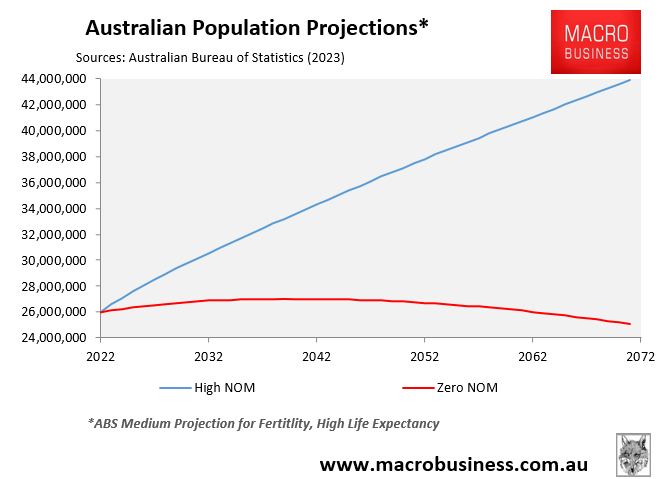
Laura (and many others) could do far worse than to simply question if any of the above is actually the lived experience of many Australians, including millions of migrants from the last generation and their families.
Then there is the not inconsiderable effect that population growth has on the costs of day-to-day grocery items, communications, and energy inter alia.
Economics 101 would note that, ceteris paribus, more demand means better scope for maintaining margins. Just look at the rental market:

Population growth means more demand. In a world where fewer people are having kids, population growth means immigration.
These issues are all worthy of consideration, discussion, planning, and policy in the public interest. All largely denied to the Australian public for more than a generation. All denied with the tacit okay of people like Laura.
Then, depression may set in, if those same people look at something as populist as an opinion poll, they will find Australians are fairly strong in their views about immigration, and they think there has been, and is, too much.
A literal conga-line of polling prior to the pandemic showed that Australians do not support high levels of immigration. For example:
- Newspoll (2018): 56% want lower immigration;
- Essential (2018): 54% believe Australia’s population is growing too fast and 64% believe immigration is too high;
- Lowy (2018): 54% of people think the total number of migrants coming to Australia each year is too high; and
- Newspoll (2018): 74% of voters support the Turnbull government’s cut of more than 10% to the annual permanent migrant intake to 163,000 last financial year.
Polling released this year showed that Australians want immigration cut hard:

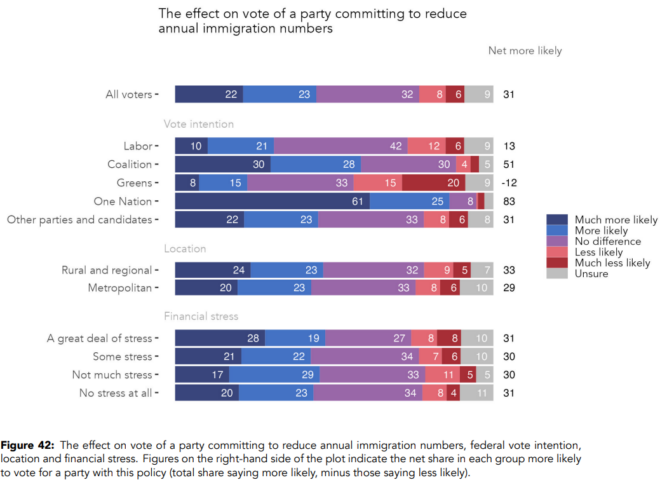
Does Laura practice mindfulness?
But let’s go on
Dutton’s determined to bang this drum
For now, let’s leave aside the fact that permanent and temporary migrant workers are filling huge holes in the care and health economies.
Laura tries another baulk here. Is she suggesting we can’t cut back on Immigration volumes and still import the health and care workers we need? Nobody is suggesting ending all immigration, but almost everyone is suggesting toning it down.
Many would heartily agree that if Australian education has become so ludicrous as to have completely stuffed up nurse and healthcare worker training, then we should welcome people coming to Australia to undertake those roles, and we should help and encourage them to become citizens, and we should also ensure they are well rewarded, housed and have good lives as Australians.
That will involve making sure that immigration works for Australians – and maybe consulting and talking with Australians about whether they think it is.
But Dutton — apparently devoid of other major policy issues — seems determined to bang this drum very loudly between now and the next election.
Previously mooted plans for a nuclear-powered energy future are vaguely drawn out in the background. Even cost-of-living issues seems to have faded in importance.
Laura could do far worse here than to ask herself if there is any issue on the national agenda not directly impacted by Immigration
- Energy demand?
- Carbon footprint?
- Housing costs?
- Infrastructure usage?
- Cost of living?
That may bring her back to why the issue has at long last percolated to the surface despite the best efforts of both mainstream sides of politics, the mainstream media, the bureaucrats, the academics, the self-righteous journalists, and the margin harvesters and property speculators.
She could then ask herself the question
‘What if the answer is No – There is no issue on the national agenda not directly impacted by immigration?’
Maybe a schnapps would help.
Then comes some red fish.
The significance of a major political leader playing so divisive a card on our community is a step that shouldn’t go unnoticed, no matter how inured to it we have become over the years in the wake of Pauline Hanson and “boat people” politics.
It is deadly simple, but very dangerous, politics.
Laura is reminding us that somewhere in the stalls there are racists – and Pauline Hanson. The reason the words ‘divisive’ and ‘card’ are in that sentence is because everyone knows race always comes onto the national agenda on a ‘card’ and that the ‘race card’ is ‘divisive’.
Once again, we are left to wonder if Laura ever sniffs something as ‘populist’ as an opinion poll.
The second aspect of what Dutton is doing which is particularly conspicuous is that he has done it without putting forward a serious proposal that would actually cut migration numbers, or materially affect the housing market.
On Thursday night, he told the House of Representatives a Coalition government would respond to the housing crisis through measures including “rebalancing the migration program and taking decisive action on the housing crisis”, which would “free up almost 40,000 additional homes in the first year”.
The plan would include a “two-year ban on foreign investors and temporary residents purchasing existing homes in Australia”; reducing “the permanent migration program by 25 per cent — from 185,000 to 140,000 for the first two years”; ensuring there are “enough” skilled and temporary skilled visas in the building trades; cut refugee and humanitarian programs; reduce “excessive” numbers of foreign students and set a cap on foreign students.
Look, on first blush, it all sounds perfectly reasonable: too many people, not enough houses.
But it is never that simple, as a former home affairs minister should know.
Laura has been a correspondent covering politics for a long time. Is she surprised they speak in vague specious terms which can be denied, avoided, or otherwise detailed away from, or scoped out with exactitude at moments of discomfiture?
When was the last time any government came to power running anything other than a ‘small target’ strategy? Where would weasel words fit into that dynamic?
How the hell Dutton comes up with his numbers is anyone’s guess. But the basic idea is:-
- Less people getting off planes means less population growth
- Less population growth means less demand for houses (but almost everything else as well)
- Less demand for houses (but almost everything else as well) means less upwards pressure on prices
- Less demand for houses (but almost everything else as well) means greater accessibility
- Greater accessibility for housing (but almost everything else as well) means easier living for an awful lot of Australians currently stressed by prices and accessibility
We can, regardless of our political views, consider that the above prima facie has a plausible logic. Can’t we?
At this point Laura returns with some numberwang.
Crunching the migration numbers
The permanent migration program is the smaller part of our overall migration system which is dominated by temporary visa holders — a development from the Howard years.
The overall net figure for how many people actually arrive in Australia is much higher. It is called the net overseas migration number.
The Morrison government announced an almost identical cut in permanent migration numbers in the 2019 budget, saying the “planning level of the Migration Program will be reduced from 190,000 to 160,000 places for four years from 2019-20”.
The pandemic rather disrupted that plan.
But the very same 2019 budget papers were forecasting that net overseas migration would be 271,700 in 2019 (compared to 190,000 permanent arrivals) before dropping ever so marginally to 271,300 in 2020 and then to 263,800 by 2022 (despite the cut of 30,000 permanent places a year).
A big reason for the fact that net overseas migration was not forecast to fall, despite the cut in the permanent number, is that more than half the people who are accepted as permanent migrants are already here when they apply.
So cutting permanent migration doesn’t necessarily mean fewer people in, or coming to, the country. Some of the migration pool just changes “class”. Others are still able to come here on temporary visas.
Dutton told Radio 2GB on Friday that “at the moment … the government’s predicting 528,000 this year” for net overseas migration.
Actually, no. That’s the figure for 2022-23 in the budget papers, which say that in the financial year just ending, net overseas migration has already fallen back to 395,000.
It is predicted to fall to 260,000 in 2024-25 (a number Dutton described as “pretty dodgy”) and then to about 235,000. (Both numbers notably also less than those forecast in 2019).
In that one stanza, there are the following numbers and years:
- 190,000
- 160,000
- 271,700
- 271,300
- 263,800
- 30,000
- 528,000
- 395,000
- 260,000
- 235,000
and
- 2019
- 2019-20
- 2020
- 2022
- 2022-23
- 2024-25
Beautifully wanged. A real professional. There would be some nerds, potentially students, hanging in there trying to work out what was being said.
The federal government has consistently understated Australia’s net overseas migration (NOM).
Last years federal budget projected NOM of 400,000 in 2022-23. It ended up being around 530,000.
December’s MYEFO projected 375,000 NOM for 2023-24 only for Tuesday’s budget to revise this up to 395,000.
NOM is more likely to come in above 450,000 for this financial year, based on the latest indicators.
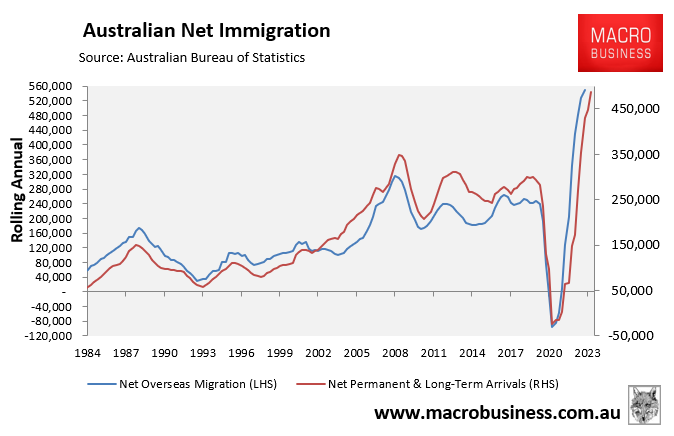
But the vast bulk of people head off to the sports section, the restaurant reviews, seek salacious detail from the last murder, or otherwise think about getting some kip, before getting to the end.
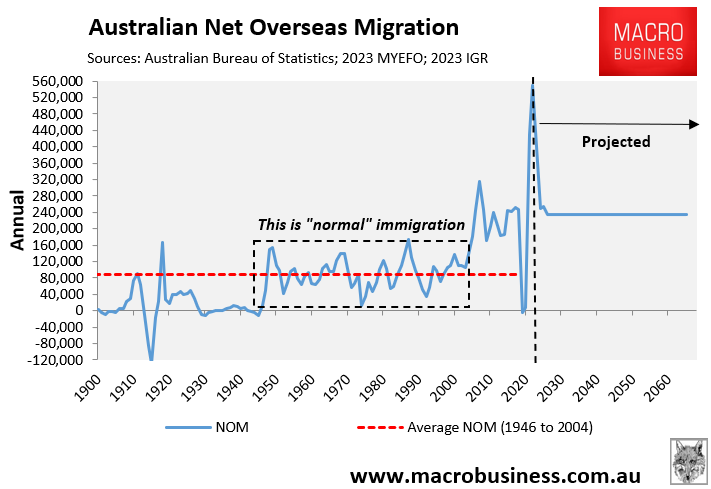
But the points Laura needs to get to, though she may not want to, are these:
- In the years between 1980 and 2006 Australia averaged an average Net Overseas Migration (NOM) of about 80 thousand per year.
- In the years from 2007 to 2020 Australia averaged an average NOM of about 220 thousand per year.
- The reason NOM should be used to measure immigration is because many students who study in Australia remain in Australia after their study – quite legally – and many of these apply to become citizens of Australia from within Australia, swapping migrant visas for their previous student visas.
- NOM crashed during Covid (readers may recall shops, factories advertising for employees in their windows).
- Since borders reopened from Covid closures, NOM was running at more than 500 thousand per annum last financial year and will top 400 thousand this financial year.
Laura rightly notes that the previous Morrison government was good at playing smoke and mirrors with immigrant numbers. Laura doesn’t go near questioning ‘Budget forecasts’ or ‘Planned’ migrant intakes from a few years ago, which have been used to convey the notion that we need to swamp the country with immigrants right at the moment to ‘catch up’ with those plans or forecasts.
Not going near the notion has spared her the indignity of having to support pure codswallop. She has also wisely steered clear of the ‘skills shortages’ baloney often wheeled out.
That brings Laura to the home straight.
Reducing a complex issue to a populist piece of political mischief
But based on the pattern we saw in the Coalition’s own 2019 budget — of little change in overall migration despite planned cuts in the permanent program — it is the opposition leader’s numbers that appear to look “pretty dodgy”.
Laura’s basic contention there, beyond the palpable truth that the Morrison government was ‘pretty dodgy’ and this may have been inherited by Peter Dutton, seems to be that cutting permanent migration may not reduce overall migration – in which case someone should join Laura for a cup of tea and explain that cutting permanent migrants and students looking to migrate after their studies will do the trick if applied for long enough.
Also worth noting is that while we may accept Laura sending those wanting to consider housing down to the Greens room, millions of Australians—particularly those queuing for rental or open house inspections and finding lots of migrants there with them—will find housing and immigration closely related.
Such is the anger about house prices and rents that Dutton is going beyond populism to tap into identifiable outrage. If he weren’t to deliver—if he is dodgy on the ‘do less’ end of the spectrum—there would be some assumption that the anger now directed towards the Albanese government would recalibrate to him.
There is lots that the current government has done in the immigration space that has not been, shall we say, a great political success — notably after last year’s High Court decision.
But it has overseen a significant cutback in net overseas migration since the post-pandemic surge.
Laura doesn’t mention that not only has the current government overseen a cutback, but that it also oversaw the surge. Indeed it exhorted, championed, encouraged and facilitated the surge.

All despite the fairly obvious opinions of the electorate. All despite the well-known implications for housing. All despite the large infrastructure investments by the States already underway. The current government could lay claim to trolling the Australian public on immigration.
And just what factors helped create that surge? The sudden return of international students is widely seen as the major factor behind the big jump in post-pandemic net overseas migration, which peaked in 2022-23.
In January 2022, the then prime minister, Scott Morrison, announced the removal of restrictions on how many hours international students could work, arguing we needed them to come here to alleviate workforce shortages, as well as get international education back on track.
The current government put a cap back on working hours in July last year.
Scott Morrison and Peter Dutton were fond of talking over the years about “pull” factors in encouraging people to travel to Australia by boat.
A capacity to work unrestricted hours (which one would think would not leave a lot of time to pursue studies) would seem to have been a pretty strong pull factor behind the huge surge in numbers turning up here in 2022-23. (In fact, it was described by the time as a “ponzi scheme” by the head of the Council for International Education.)
But Dutton is now proposing to once again lift the allowable work hours for international students to 60 hours a fortnight — a much more generous allowance than countries like the United States, Canada, New Zealand, and the United Kingdom.
Laura rightly identifies the culpability of former Prime Minister Scott Morrison, and the Education sector in the immigration issue, and crashes onto the reef of the idea that international students are to a high degree motivated by work rights in Australia. Good on her for acknowledging that.
Then comes the denouement:
Based on past experience, it is hard to see how that idea can possibly represent a coherent part of the Coalition’s rhetoric or policy this week.
In the meantime, the complex set of issues that governments need to address on housing get sidelined. The federal government would argue it has done a lot to try to start to address the housing shortage. It is not clear that it is enough. It is not something that can be fixed overnight.
It’s a shame, though, a massively complex issue has been reduced to a populist and misleading piece of political mischief.
Laura has been a political correspondent for quite some time. When was the last time she saw a ‘coherent’ policy from either side of Australian politics?
The Budget Dutton was replying to when he divulged his immigration thinking was a series of band aids. The only coherence Australians see in their mainstream politicians are can kicks.
She approaches the end with a hat tip about housing but without going anywhere near the idea that the 900,000 new people needing abodes arriving in Australia last financial year and this are a factor in the housing dynamic.
Similarly, she goes nowhere near suggesting that it may be better not to add hundreds of thousands of new people needing housing to an issue that can’t be fixed overnight.
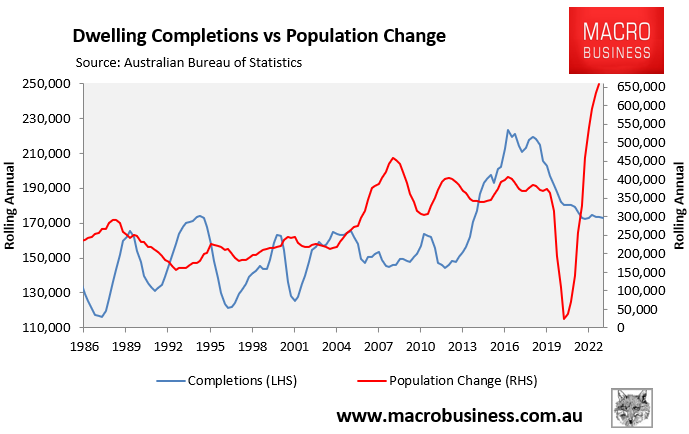
Even though Mr. Dutton may be misleading the public on a topic that is receiving more attention, the populism to which he descends is not unusual for Australian politicians, bureaucrats, and media figures.
Maybe with the issue front and centre in the lead-up to the next federal election, Australians can get a little more chance to have their views acted upon, with some of those same politicians, bureaucrats, and media identities needing to account for their positions and reporting on them.